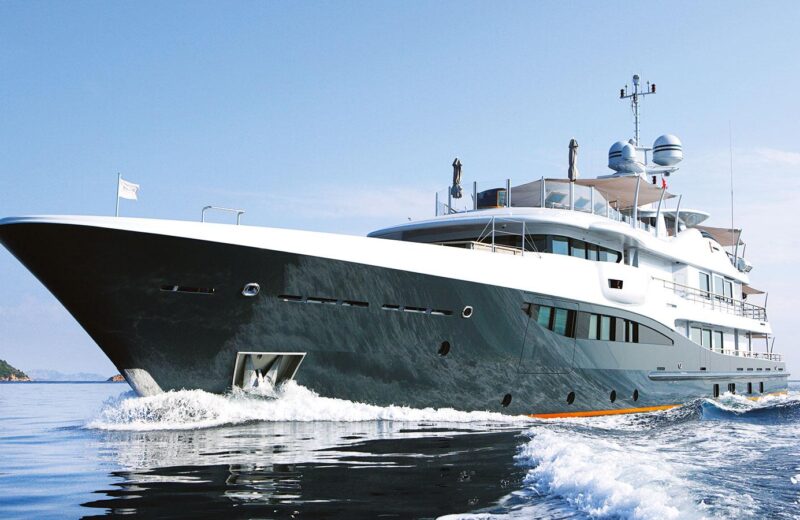Flagship: Changing public perception

The public perception of superyachts has been shaped through a seemingly endless array of Bond villains, Jordan Belfort (The Wolf of Wall Street) or Tenet — the plaything of the super rich nestled in the French Riviera. The mainstream news media has certainly done superyachting no favours, traditionally portraying the industry as a centre for hedonism, wealth and excess.
Yet we in superyachting know very well this is not the case, the creation of a Covid-19 test kit and vital climate change research in the polar regions are just two philanthropic examples far removed from the portrayal of mainstream media. The question is not what can superyachting do better, but how can it better represent itself?
“Countless times it has been noted that the baddie owns a superyacht, but in reality that is a cheap shot,” Patrick Coote, Head of Europe, Northrop & Johnson, told Superyacht Investor (SYI).
“It tends to come from the tabloids, it is the sort of thing the Daily Mail loves to do. Its done in a cheap way without any real understanding of who superyacht owners are or the money that owners put back into the economy. Or the costs of running a superyacht and just how much that can support a local area.”
Collective voice is key
Collective voice is key. Since its inception, The Superyacht Life Foundation has been steadily turning the tide on public perception of our industry. A key way of doing so has been creating partnerships. Superyacht Life has so far partnered with likes of Rybovich, Lurssen, Feadship, Benetti, Burgess and Camper and Nicholsons to name a few.
Mark de Jong, marketing manager, Superyacht Life, told SYI: “There’s so much good within the industry that doesn’t get the recognition it deserves. From philanthropic owners to the innovative builders and designers, we’re an industry that’s not short on good stories.”
According to de Jong the industry has been secretive, which he says is unsurprising given the value of projects and non-disclosure agreements involved.
“Companies are individually focused on brand building and selling their products. There’s nothing wrong with that, of course, but it doesn’t do enough to address the wider issue – our industry’s poor perception and misrepresentation. That’s where the collective approach is crucial.”
The industry agrees, Superyacht Life reported in a recent webinar poll 83% attendees believed closer collaboration would better promote superyachting.
Robert Van Tol, executive director, Water Revolution Foundation, agrees a more pro-active communication approach by the superyacht industry and increased access to information will give a more balanced picture in mainstream media.
‘Cannot be achieved individually’
“This tremendous task typically lends itself for a collective approach. It cannot be achieved individually and is in everyone’s favour,” Van Tol told SYI.
“It is also a stage that comes before individual commercial interest, as this audience is not reached by marketing efforts as they are not yet in the market. Individual marketing efforts are focused on potential customers and require a direct return on investment. Collective efforts can be focused on the target audience as a whole, which has typically a lower guarantee of return on investment, but when divided by many, it is feasible and beneficial.”
Efforts to reduce environmental impact will also contribute to a better image said Van Tol. “Especially if we can be successful in turning sustainability into the new luxury. Yachting is about enjoying the beautiful oceans, it then cannot come at a cost of that same natural resource. In fact, the success of the yachting industry directly depends on the health of the oceans, so it is only logical to lower our impact on it and better look after it for a sustainable business.”
The stories behind the superyachts are a focal point of Superyacht Life’s campaign. Superyachts have always been feats of engineering, but in the last 20 years as vessel sizes have steadily began growing in size that feat has grown evermore impressive. Superyacht Life uses software techniques and sponsored content in order to reach a wider audience outside the superyachting sphere.
‘It’s a long term mission’
De Jong said: “It’s a long term mission but we’re certainly moving in the right direction. The fact that there is far more activity in the sustainability field helps, as do the many philanthropic and environmental initiatives going on across the industry that now get more coverage in mainstream press.
“We have realised that opening our doors even a little, can help change perceptions. Showing off our amazing craftsmanship or highlighting the sorts of remote destinations we can travel to by yacht are important steps towards changing the conversation.”
How to change public perception is the million dollar question according to Coote, but he believes that we are already seeing a shift in the right direction. “I don’t think there is a magic wand we can wave to turn around 100 years of negative PR, but at the same time there’s plenty we can be doing in small doses to gradually give a new, fresh and more accurate portrayal.”
‘100 years of negative PR’
Going are the days of superyachts as toys for the super rich. New owners, in a new age of self-made tech billionaires, see no attraction in the superyachts of yesteryear. As philanthropic research, expedition yachting and sustainability have become key drivers new superyachts have come to the fore.
Take Dragonfly, owned by Google co-founder Sergey Brin. The 73m superyacht has delivered disaster relief to stricken areas including Vanuatu, Haiti and the Bahamas since 2015 working under Brin’s charity, Global Support and Development.
Then there is Gene Machine, a 55m vessel owned by American scientist Jonathan Rothberg. The yacht’s upper salon has become a laboratory where Rothberg is developing and prototyping a 3D-printed home test kit for Covid-19.
Undoubtedly there is still some way to go to turn the tide on negative perceptions, but as times change attitudes to do too. With change being the operative word for 2020, now that M is gone, perhaps change too is afoot for 007. Wouldn’t it be a sight to see Mr Bond aboard his Class A1 icebreaker yacht — it’s not like there isn’t room for gadgets.
Subscribe to our free newsletter
For more opinions from Superyacht Investor, subscribe to our email newsletter.

